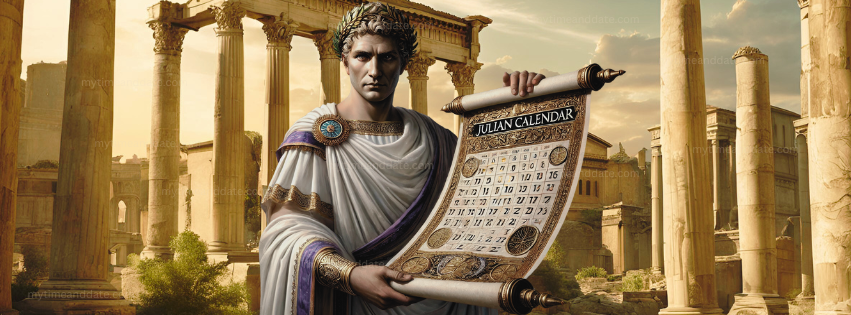The Julian Calendar was an important step in the history of timekeeping. Created by Julius Caesar in 45 BCE, it was one of the first calendars to introduce a leap year. This system was revolutionary because it was more accurate than the Roman calendar it replaced. Let’s explore what makes the Julian Calendar unique, its history, and why it’s still remembered today.
What Is the Julian Calendar?
The Julian Calendar is a solar calendar, meaning it is based on the Sun’s cycles. A year in this calendar has 365 days, and every four years, there is a leap year with 366 days. This leap year system helped fix the problems of older calendars, which didn’t align well with the seasons.
Julius Caesar worked with astronomers to create this calendar, especially with Sosigenes, a Greek expert in astronomy. Together, they decided to add the extra day every four years to keep the seasons and calendar aligned.
Why Was the Julian Calendar Needed?
Before the Julian Calendar, Rome used a lunar calendar. This older system was based on the Moon’s cycles, but it had a big problem, that is. it didn’t match the solar year. Over time, the months and seasons got out of sync. For example, spring might fall in what was supposed to be summer!
Julius Caesar wanted a calendar that would be more reliable. He introduced the Julian Calendar to solve these issues and ensure that important events like farming and festivals happened at the right times of the year.
How Did the Julian Calendar Work?
In the Julian Calendar:
- A year had 12 months, just like today.
- Most months had either 30 or 31 days, except February, which had 28 days in a normal year and 29 in a leap year.
- Leap years occurred every four years to adjust for the fact that the Earth takes about 365.25 days to orbit the Sun.
This system worked well for centuries, but it wasn’t perfect. Over time, small errors added up. The actual solar year is slightly shorter than 365.25 days (it’s about 365.2422 days). As a result, the calendar drifted slowly out of alignment with the seasons.
The Julian Calendar and the Gregorian Calendar
By the 1500s, the errors in the Julian Calendar had caused a shift of about 10 days. To fix this, Pope Gregory XIII introduced the Gregorian Calendar in 1582. The Gregorian Calendar is the one most of the world uses today.
The main difference between the two calendars is how they handle leap years. In the Gregorian Calendar, leap years are skipped in certain cases to keep the calendar more accurate. For example, a year divisible by 100 is not a leap year unless it’s also divisible by 400.
Even though the Julian Calendar was replaced, some countries and religions still use it for specific purposes, like religious holidays.
Why Is the Julian Calendar Important?
The Julian Calendar was a groundbreaking achievement in its time. It introduced a more scientific way of measuring years and aligning them with the seasons. It showed how astronomy and math could work together to solve real-world problems.
Today, the Julian Calendar is a reminder of how ancient civilizations used their knowledge to shape the world. It’s fascinating to think about how people 2,000 years ago worked so hard to make sense of time, just like we do today.
FAQs:
1. What is the Julian Calendar?
The Julian Calendar is a solar calendar introduced by Julius Caesar in 45 BCE. It has 12 months, 365 days in a regular year, and adds a leap year every four years with 366 days to align with the Sun’s cycles.
2. Why was the Julian Calendar created?
The Julian Calendar was created to fix the problems of the Roman lunar calendar, which didn’t match the solar year and caused seasonal misalignment. It introduced a leap year system to keep seasons in sync with the calendar.
3. Who helped Julius Caesar design the Julian Calendar?
Julius Caesar worked with Sosigenes, a Greek astronomer, to create the Julian Calendar. Sosigenes advised the leap year system to improve the accuracy of timekeeping.
4. How did the Julian Calendar handle leap years?
The Julian Calendar added a leap year every four years. This system added an extra day to February to account for the fact that the solar year is slightly longer than 365 days.
5. What are the main differences between the Julian and Gregorian calendars?
The Julian Calendar has a simpler leap year system, adding a day every four years. The Gregorian Calendar is more accurate, skipping certain leap years to better match the solar year.
6. Why did the Julian Calendar drift out of alignment?
The Julian Calendar assumed a solar year was 365.25 days, but the actual length is about 365.2422 days. Over centuries, this small error caused the calendar to drift out of alignment with the seasons.
7. Which countries still use the Julian Calendar?
Some Eastern Orthodox Churches and countries use the Julian Calendar for religious holidays. It is not widely used for civil purposes today.
8. How did the Julian Calendar influence modern calendars?
The Julian Calendar was a major step in timekeeping, influencing the Gregorian Calendar, which corrected its errors and became the global standard.
9. What role did astronomy play in the Julian Calendar?
Astronomy played a key role in the Julian Calendar’s design. By studying the Sun’s cycles, ancient astronomers like Sosigenes helped create a system that better aligned with the solar year.
10. How did people react to the Julian Calendar?
The Julian Calendar was a major improvement over older systems, and it was widely adopted in the Roman Empire. It helped unify timekeeping across the empire and improved agricultural planning.
11. Why is the Julian Calendar still remembered?
The Julian Calendar is remembered for its revolutionary leap year system and its impact on history. It shows how ancient civilizations advanced timekeeping using science and math.
12. Can we still use the Julian Calendar today?
The Julian Calendar is not practical for modern use because it’s less accurate than the Gregorian Calendar. However, it remains important for historical and religious purposes.



